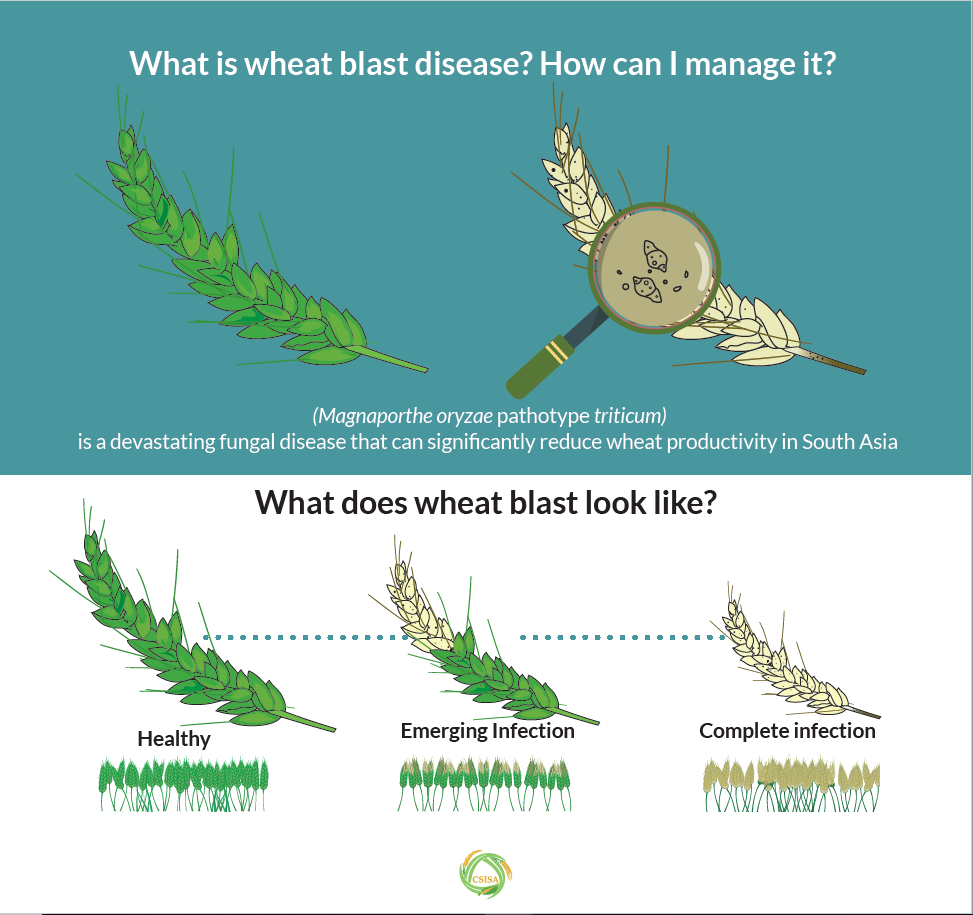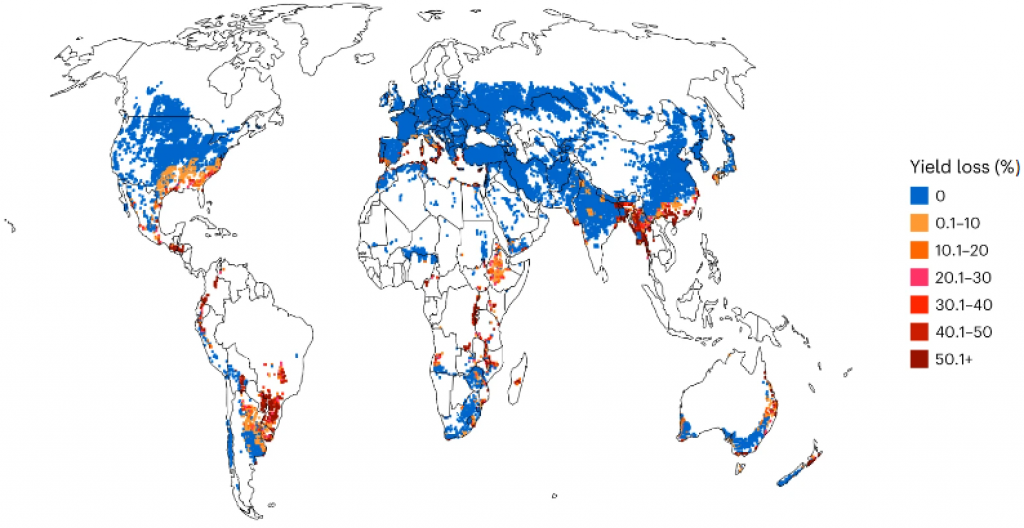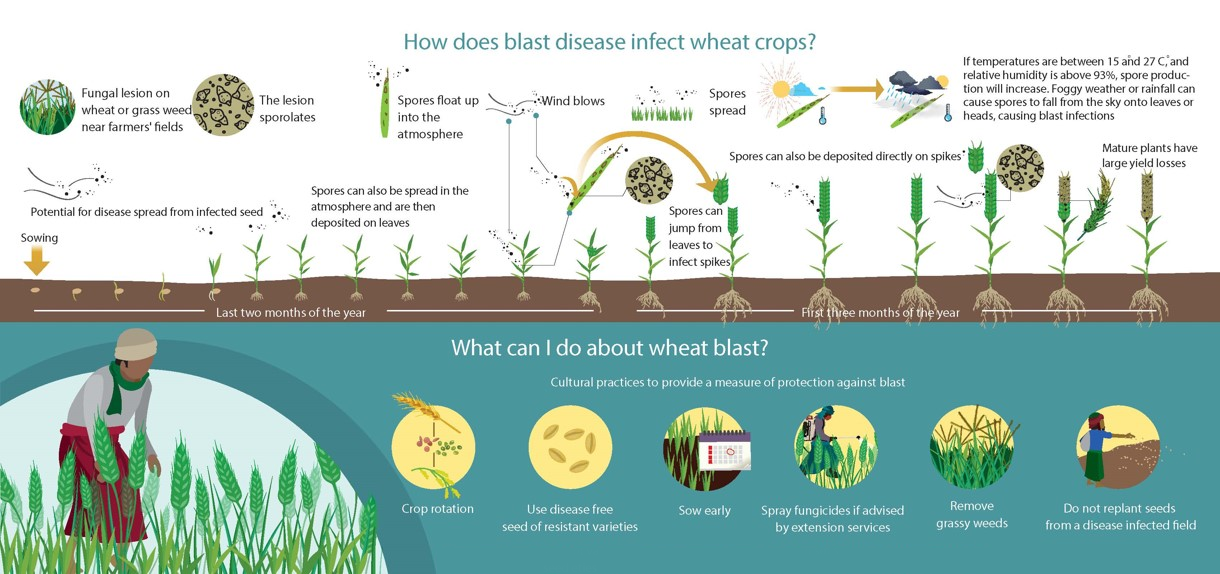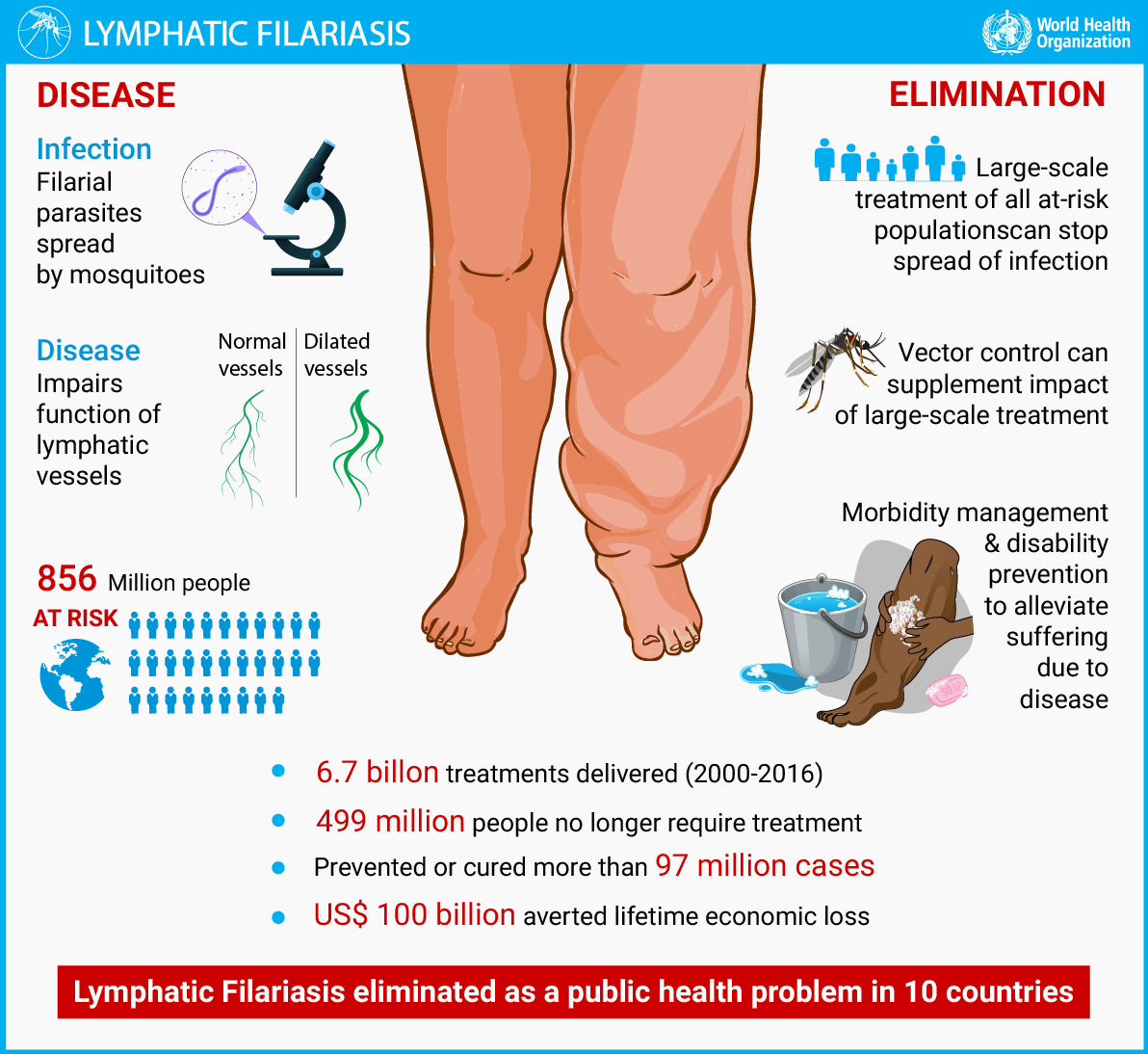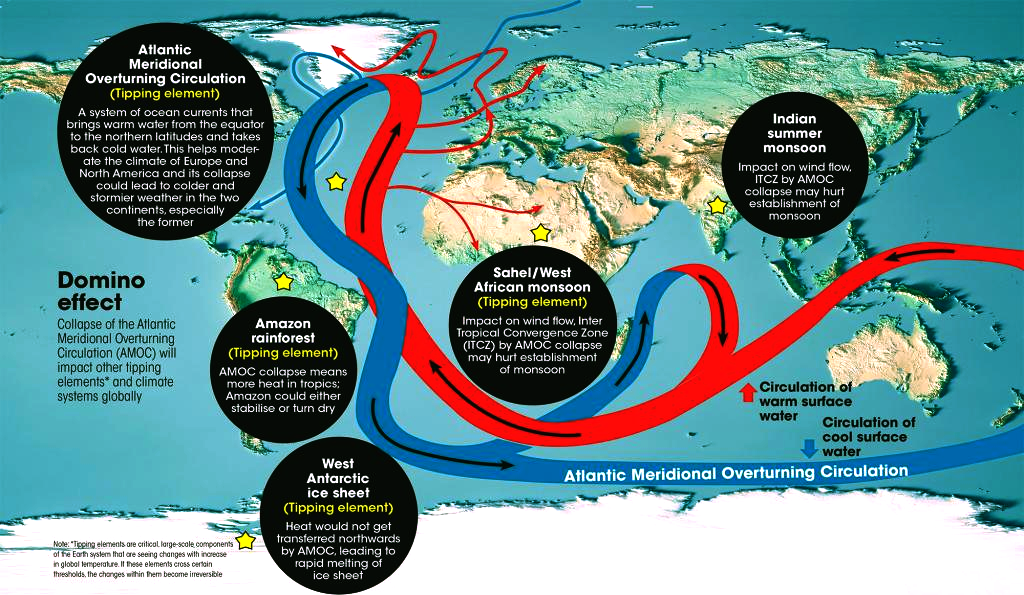Biodiversity & Environment
UN World Restoration Flagships
For Prelims: United Nations, World Restoration Flagship Award, Restoring Mediterranean Forests Initiative, Living Indus initiative, Terai Arc Landscape Initiative, UN Environment Programme, Food and Agriculture Organization
For Mains: World Restoration Flagships, Environmental Pollution & Degradation, Conservation
Why in News?
The United Nations has recognized seven initiatives from regions spanning Africa, and Latin America, the Mediterranean, and Southeast Asia as World Restoration Flagships.
- These initiatives, aimed at reviving ecosystems on the brink of degradation, hold promise for environmental conservation and socio-economic development.
- The combined efforts of these initiatives are projected to restore approximately 40 million hectares of land and generate around 500,000 employment opportunities.
What are the 7 World Restoration Flagships recently Recognized by the UN?
- The Restoring Mediterranean Forests Initiative:
- Involves the countries of Lebanon, Morocco, Tunisia, and Türkiye.
- It consists of a novel approach said to have protected and restored natural habitats and vulnerable ecosystems.
- Around 2 million hectares of forests have been restored since 2017; aims for over 8 million by 2030.
- The Living Indus initiative:
- Approved by Pakistan parliament post-2022 climate change-induced floods. Its official launch took place at the 27th Conference of Parties to the UN Framework Convention on Climate Change in Sharm el-Sheikh.
- Aims to restore 25 million hectares of the Indus river basin by 2030.
- It designates the Indus River as a living entity with rights, a measure taken to protect rivers elsewhere as well.
- It involves Australia, Bangladesh, Bolivia, Brazil, Canada, Ecuador, India, New Zealand, Peru and Sri Lanka.
- The Acción Andina Social Movement:
- It is led by the non-profit Andean Ecosystems Association (ECOAN) and aims to protect and restore one million hectares of Andean forests.
- Andean forests are a type of tropical and subtropical forest that grow along the slopes of the Andes mountains in South America.
- The initiative also works to secure land titles for local communities and protect the forest from mining and timber exploitation.
- It is led by the non-profit Andean Ecosystems Association (ECOAN) and aims to protect and restore one million hectares of Andean forests.
- Sri Lanka Mangrove Regeneration Initiative:
- It is a science-driven programme co-led by local communities. It focuses on the restoration of natural balance in the ecosystem.
- Since its launch in 2015, efforts have led to 500 hectares of restored mangroves, according to the UN statement.
- Targets restoration of 10,000 hectares of mangroves by 2030.
- Terai Arc Landscape(TAL) Initiative:
- Aimed to restore the forests of critical corridors of the TAL in collaboration with local communities working as citizen scientists, community-based anti-poaching units, and forest guards, among others.
- Initiative covers measures like the restoration of 66,800 hectares of Nepal’s forests, which is said to improve the livelihoods of about 500,000 households in the country.
- It also supported the tiger population in the landscape shared by India and Nepal, which increased to 1,174.
- Aims to restore 350,000 hectares of forests by 2030.
- Regreening Africa’s Agriculture:
- It increases carbon storage, boosts crop and grass yields, makes soil more resilient (by preventing floods) and treats it with fixed nitrogen that acts as a natural fertiliser.
- Growing Forests in Africa's Drylands Initiative:
- Expands restoration from 41,000 to 229,000 hectares by 2030.
- Involves African farmers, planting tens of millions of trees annually.
- Creates over 230,000 jobs, supporting sustainable development.
What are UN World Restoration Flagships?
- About:
- The World Restoration Flagships are part of the UN Decade on Ecosystem Restoration led by the UN Environment Programme (UNEP) and the Food and Agriculture Organization of the UN (FAO) which aims to prevent, halt, and reverse the degradation of ecosystems on every continent and in every ocean.
- The UN General Assembly has declared 2021–2030 as the UN Decade on Ecosystem Restoration.
- The UN recognizes the World Restoration Flagships through the World Restoration Flagship Award.
- This award is part of the UN Decade on Ecosystem Restoration, spearheaded by UNEP and FAO, which aims to counteract ecosystem degradation across all continents and oceans.
- Recipients of this award become eligible for technical and financial assistance from the UNO.
- The awards track notable initiatives following global commitments to restore one billion hectares (an area larger than China).
- The World Restoration Flagships are part of the UN Decade on Ecosystem Restoration led by the UN Environment Programme (UNEP) and the Food and Agriculture Organization of the UN (FAO) which aims to prevent, halt, and reverse the degradation of ecosystems on every continent and in every ocean.
- Significance:
- Global recognition and celebration of their restoration success stories.
- Technical and financial support of up to USD 500,000 per selected initiative (only for developing countries).
- Attraction of global attention and investments.
- Feature in the UN Decade’s publications, campaigns, outreach, advocacy, and education efforts.
- Listing in the UN Secretary-General’s Report to the General Assembly.
What is Ecological Restoration?
- About:
- It is the process of aiding the recovery of ecosystems that have been degraded, damaged, or destroyed.
- Causes of Degradation:
- Human activities like selective logging, road building, poaching, overfishing, invasive species, land clearing, urbanization, coastal erosion, and mining can lead to damage, degradation, or destruction of ecosystems.
- Aims and Objectives:
- Ecological restoration aims to initiate or accelerate ecosystem recovery by creating conditions for plants, animals, and microorganisms to carry out the recovery process themselves.
- Methods and Actions:
- Restoration may involve actions like removing invasive species, reintroducing lost species or functions, altering landforms, planting vegetation, changing hydrology, and reintroducing wildlife.
- Restoration is not a one-time activity; it continues as the ecosystem recovers and matures. Unforeseen barriers may arise during the recovery process.
- Restoration and Conservation:
- Restoration is not a substitute for conservation. While it can restore biodiversity, structure, and function to ecosystems, it should not be used to justify destruction or unsustainable use.
- India's Restoration Initiatives:
UPSC Civil Services Examination, Previous Year Questions (PYQs)
Prelims
Q1. Which of the following can be threats to the biodiversity of a geographical area? (2012)
- Global warming
- Fragmentation of habitat
- Invasion of alien species
- Promotion of vegetarianism
Select the correct answer using the codes given below:
(a) 1, 2 and 3 only
(b) 2 and 3 only
(c) 1 and 4 only
(d) 1, 2, 3 and 4
Ans: (a)
Q2. Biodiversity forms the basis for human existence in the following ways: (2011)
- Soil formation
- Prevention of soil erosion
- Recycling of waste
- Pollination of crops
Select the correct answer using the codes given below:
(a) 1, 2 and 3 only
(b) 2, 3 and 4 only
(c) 1 and 4 only
(d) 1, 2, 3 and 4
Ans: (d)
Mains
Q. How does biodiversity vary in India? How is the Biological Diversity Act,2002 helpful in the conservation of flora and fauna? (2018)
Governance
Potential of India’s AVGC-XR Sector
For Prelims: Animation, Visual Effects, Gaming & Comics and Extended Reality (AVGC-XR) sector, Intellectual property, Potential of India’s AVGC-XR Sector.
For Mains: Potential of India’s AVGC-XR Sector, AVGC Sector, its importance and related issues, Government policies & interventions.
Why in News?
India’s Animation, Visual Effects, Gaming & Comics and Extended Reality (AVGC-XR) sector is all set for a quantum leap in the next five to six years.
What is the Outlook of India’s AVGC-XR Sector?
- Industry Landscape:
- India boasts a robust ecosystem with over 4,000 studios, with key hubs in Mumbai, Bengaluru, Pune, Hyderabad, and Chennai. Additionally, smaller towns are witnessing a surge in studio establishments, highlighting the sector's widespread expansion.
- India's rich cultural heritage, diverse art forms, and skilled artists serve as the foundation for its prowess in visual arts. The industry is now recognizing the immense potential for value creation and employment generation within this domain.
- Employment:
- Most of the direct job positions will come for content developers, animators, pre- and post-production artists, pre-visualisation artists, compositors, etc.
- The industry is witnessing a high pace of growth with some segments within AVGC-XR already growing at 30 or 35% annually.
- Projected Growth:
- The AVGC-XR sector, currently employing 2.6 lakh individuals, anticipates creating 23 lakh direct jobs by 2032, with revenues expected to soar to over USD 26 billion by 2030 from the current USD 3 billion.
- India’s contribution to the global AVGC-XR sector is a mere 0.5%, as per the government data, India has the potential to capture 5% (USD 40 billion) of the global market share by the year 2025, with an annual growth of around 25-30% and creating over 1,60,000 new jobs annually.
What are the Challenges Associated to AVGC Sector?
- Lack of Authentic Data:
- Non-availability of data such as employment, industry size, education intuitions, etc. for the AVGC sector, makes decision-making tougher for entities.
- Skill Gap in Education and Employment sector:
- Creation of the AVGC ecosystem within the country requires a workforce with specialised skills for various roles such as animators, developers, designers, localization experts, product managers, etc.
- Infrastructure Constraints:
- In the absence of adequate training infrastructure, there is deterioration in the quality of training being delivered to students, thus impacting the quality of output and human resources for the AVGC industry.
- Less focus on Research Development:
- There is also a need to develop research related narrative for the AVGC-XR sector, so that dedicated focus can be given to it.
- Absence of an AVGC Academic Reference Point:
- There is no apex institute in India for the AVGC sector unlike other sectors such as engineering, design, management, packaging, etc.
- Availability of Funds:
- At present there is no dedicated fund available for the promotion of the AVGC sector which acts as an obstacle for the growth of the sector in India.
- Lack of Globally-Popular Indian IPs:
- The AVGC sector in general has suffered a lack of original Indian intellectual property as most work in this sector is outsourced.
- Animation industry is dominated by services to other countries and thus it is important to incentivize local production with additional concessions to increase local IP.
What are the Government Initiatives to Promote the AVGC-XR Sector?
- Educational Integration:
- The National Education Policy (NEP) 2020 has integrated creative arts, design, and sports into the school curriculum from Class 6 onwards, fostering a conducive environment for nurturing talent in AVGC-XR.
- Around 5,000 CBSE and state board schools have introduced AVGC-XR learning, with plans for expansion nationwide. This initiative aims to redefine animation as a form of family entertainment suitable for all ages.
- Policy Framework:
- To unleash the scope of the AVGC sector, Union Budget 2022-23 announced for setting up of an AVGC Promotion Task Force to recommend ways to realise and build domestic capacity for serving Indian markets and the global demand.
- Collaborative efforts between industry bodies like FICCI, ABAI (Association of Bangalore Animation Industry), SAIK (Society of AVGC Institutions in Kerala), and government entities are underway to formulate robust policies tailored to each state.
- States like Karnataka, Maharashtra, and Telangana have already implemented proactive measures to support the sector's growth.
 |
 |
Way Forward
- Continued emphasis on skill development programs tailored to the AVGC-XR industry is essential. This includes both formal education initiatives integrated into school curriculums and vocational training programs to equip aspiring professionals with the necessary skills.
- Foster closer collaboration between industry players and educational institutions to ensure that curriculum and training programs are aligned with industry needs. Internship opportunities, guest lectures, and industry-sponsored projects can bridge the gap between academia and industry.
Agriculture
Climate Change and Wheat Blast
For Prelims: Wheat Blast, El Niño, Wheat Blast (WB), Climate Change, Food Security.
For Mains: Linked Between Climate Change and Wheat Blast, Major Impacts of Climate Change on Indian Agriculture.
Why in News?
Recently, a new study has been published titled-Production vulnerability to wheat blast disease under climate change, which has warned of links between warming Climate and the fungal plant disease Wheat Blast (WB).
- The study traces the history of WB outbreaks, emphasizing its expansion beyond its original location in South America to Bangladesh in 2016 and Zambia in 2018. The disease is linked to weather conditions influenced by phenomena like El Niño.
What is a Wheat Blast Disease (WB)?
- About:
- Wheat blast disease is a highly destructive fungal infection that primarily affects wheat crops.
- It poses a significant threat to food security and safety, particularly in tropical regions of South America and South Asia.
- The disease is caused by the fungus Magnaporthe oryzae pathotype triticum (MoT).
- Symptoms:
- Leaf Lesions: Small, oval to spindle-shaped lesions appear on the leaves. These lesions may initially be yellow or tan and eventually turn brown or necrotic. They often have a yellow halo surrounding them.
- Stem Lesions: Similar lesions can also develop on the stems of the wheat plants. These lesions can girdle the stem, leading to wilting and lodging of the plant.
- Spikelet Symptoms: Infected spikelets may become blackened and elongated, giving them a spindle-like appearance. This symptom is particularly prominent during the reproductive stage of the plant.
- Impact on Wheat Crops:
- The fungus directly targets the wheat ear, causing it to shrivel and deform within a remarkably short period, often less than a week from the first symptoms.
- This rapid onset leaves farmers with little time to respond, leading to substantial yield losses.
- Wheat blast spreads through various means, including infected seeds, crop residues, and airborne spores capable of traveling long distances.
- The pathogen can infect all aerial parts of the wheat plant, but the most significant damage occurs when it affects the wheat ear.
What are the Key Highlights of the Study?
- Climate Change Impact on Wheat Blast:
- Wheat Blast currently poses a threat to 6.4 million hectares and by 2050, Climate Change is likely to make the situation worse and threaten 13.5 million hectares of cropland.
- Wheat blast is also linked with weather conditions like El Nino.
- A study published in 2018 by the Annual Review of Phytopathology too revealed that all the severe epidemics of wheat blast occurring across South America and Asia during the wet and warm years of 1987, 1997, 2002, 2009, 2012 and 2015 coincided with weather conditions dominated by the El Nino phenomenon.
- Wheat blast alone has the potential to reduce worldwide wheat production by 13%, highlighting the severity of its impact on Global Food Security.
- Vulnerability by Region:
- South America and Africa are identified as the most vulnerable regions to wheat blast in the future climate.
- By 2050, up to 75% of wheat acreage in these regions could be at risk.
- Future Spread and Impact:
- There is potential expansion of wheat blast into new territories, including countries like Uruguay, Ethiopia, Kenya, and Congo.
- It also highlights projections for increased vulnerability in regions like Oceania and North America.
- Previously unaffected countries like Japan, Italy, Spain, and New Zealand are identified as potential targets for wheat blast, highlighting the global nature of the threat.
- Impact on European Region:
- The cold climate in Europe and other countries where snow falls reduces the probability of infection. But climate change will potentially alter the distribution of different insect pests and diseases over time.
- It is possible for European places near the Mediterranean to experience a favourable climate for fungal infection.
- This includes Italy and parts of southern France and Spain.
- Impact on India:
- In India, some parts of the country may become less vulnerable to wheat blast if dry seasonal conditions with more frequent severe high temperatures (over 35 degrees Celsius) occur in the later half of the wheat-growing season in future climates.
- Although the risk of wheat blast infection is decreased by such high temperatures, they also create terminal heat stress, which lowers India's potential output.
What are the Adaptation Strategies Suggested in the Study?
- Shift to Less Susceptible Crops:
- Given the threat to important wheat-growing areas around the world from wheat blast, farmers may need to shift to less susceptible crops to mitigate production and financial losses.
- Multiple Strategies:
- It is suggested to adopt multiple strategies to manage the disease, for instance, maize cultivation is gradually replacing wheat in midwest Brazil.
- Breeding blast-resistant wheat is also a very important strategy that could mitigate future losses in new vulnerable areas and has already been initiated.
- Appropriate Sowing Date:
- Wheat blast-promoting conditions can also be avoided by choosing the appropriate sowing date. The adjustment in planting dates is another effective mitigation strategy against the disease.
- Avoid Early Planting:
- Rain, followed by hot, humid weather during the flowering stage, can promote disease development. It is recommended to avoid early planting in central Brazil and late planting in Bangladesh, as these periods coincide with high temperatures and relative humidity due to increased precipitation levels.
What are the Measures to Combat Wheat Blast?
- The wheat blast-resistant varieties produced by CIMMYT (International Maize and Wheat Improvement Centre) in collaboration with National Agricultural Research Systems partners have proven useful in reducing the impact of wheat blast.
- Developing and promoting wheat varieties resistant to wheat blast is a critical aspect of mitigating the impact of this devastating disease. Examples of wheat varieties that exhibit resistance to wheat blast, including Rmg8 and 2NS
- Rmg8 is a wheat variety developed by researchers at the CIMMYT, which possesses genetic resistance to wheat blast conferred by a specific gene known as Rmg8.
- The 2NS involves transferring a segment of chromosome 2N from a wild relative of wheat, Thinopyrum ponticum, to cultivated wheat varieties. This translocation has been found to enhance resistance to various fungal diseases.
UPSC Civil Services Examination, Previous Year Question (PYQ)
Prelims
Q.1 How is permaculture farming different from conventional chemical farming? (2021)
- Permaculture farming discourages monocultural practices but in conventional chemical farming, monoculture practices are predominant.
- Conventional chemical farming can cause an increase in soil salinity but the occurrence of such phenomenon is not observed in permaculture farming.
- Conventional chemical farming is easily possible in semi-arid regions but permaculture farming is not so easily possible in such regions.
- Practice of mulching is very important in permaculture farming but not necessarily so in conventional chemical farming.
Select the correct answer using the code given below.
(a) 1 and 3
(b) 1, 2 and 4
(c) 4 only
(d) 2 and 3
Ans: (b)
Q.2 Which of the following is the chief characteristic of ‘mixed farming’? (2012)
(a) Cultivation of both cash crops and food crops
(b) Cultivation of two or more crops in the same field
(c) Rearing of animals and cultivation of crops together
(d) None of the above
Ans: (c)
Q.3 With reference to micro-irrigation, which of the following statements is/are correct? (2011)
- Fertilizer/nutrient loss can be reduced.
- It is the only means of irrigation in dry land farming.
- In some areas of farming, receding of ground water table can be checked.
Select the correct answer using the codes given below:
(a) 1 only
(b) 2 and 3 only
(c) 1 and 3 only
(d) 1, 2 and 3
Ans: (c)
Mains
Q.1 What are the present challenges before crop diversification? How do emerging technologies provide an opportunity for crop diversification? (2021)
Q.2 How has India benefited from the contributions of Sir M. Visvesvaraya and Dr. M. S. Swaminathan in the fields of water engineering and agricultural science respectively? (2019)
Governance
Nazool Land
For Prelims: Demolition Drive, Nazool Lands (Transfer) Rules, 1956, Nazool Land, Demolition Drive, Encroachment.
For Mains: Nazool Land, Law Against Demolition Drives, Judgements & Cases.
Why in News?
Recently, violence erupted in Haldwani city of Nainital District, Uttarakhand after the city administration conducted a Demolition Drive to remove Encroachment at the site of a mosque and madrasa, allegedly on Nazool Land.
- As per the administration, the property where the two structures are situated is registered as the Municipal Council’s Nazool land.
What is Nazool Land?
- About:
- Nazool land is owned by the government but most often not directly administered as state property.
- The state generally allots such land to any entity on lease for a fixed period, generally between 15 and 99 years.
- In case the lease term is expiring, one can approach the authority to renew the lease by submitting a written application to the Revenue Department of the local development authority.
- The government is free to either renew the lease or cancel it — taking back Nazool land.
- In almost all major cities of India, Nazool land has been allotted to different entities for a variety of different purposes.
- Nazool land is owned by the government but most often not directly administered as state property.
- Emergence of Nazool Land:
- During British rule, kings and kingdoms which opposed the British frequently revolted against them, leading to several battles between them and the British Army. Upon defeating these kings in battle, the British would often take their land away from them.
- After India got Independence, the British vacated these lands. But with kings and royals often lacking proper documentation to prove prior ownership, these lands were marked as Nazool land — to be owned by the respective state governments.
- Purpose of Nazool Land:
- The government generally uses Nazool land for public purposes like building schools, hospitals, Gram Panchayat buildings, etc.
- Several cities in India have also seen large tracts of land denoted as Nazool land used for housing societies, generally on lease.
- While several states have brought in government orders for the purpose of framing rules for Nazool land, The Nazool Lands (Transfer) Rules, 1956 is the law mostly used for Nazool land adjudication.
What is an Encroachment?
- About:
- It is the unauthorised use or occupation of someone else’s property. This can occur on abandoned or unused spaces if the legal owner is not actively involved in its upkeep. It is important for property owners to be aware of the legal steps to take and their rights in such cases.
- Urban encroachment refers to the unauthorised occupation or use of land or property within urban areas.
- This could include illegal construction, squatting, or any other form of occupation without proper permission or legal rights.
- Land encroachment, as defined by Section 441 of the Indian Penal Code (IPC), 1860, is the act of unlawfully entering someone else’s property without permission to commit an offence, threaten possession of the property, or stay on the land uninvited.
- Procedure for Removing Illegal Encroachments:
- Before taking any action, the municipal authorities are usually required to issue notices to the individuals or establishments involved in illegal encroachments.
- Courts, including the Supreme Court, have emphasised the importance of due process and have often ruled that proper notice and opportunity to be heard are essential before any demolition is carried out.
- In the 1985 Olga Tellis case, emphasising the right to livelihood and rights of slum dwellers, SC had noted that the right to livelihood is a part of right to life.
- If the individuals fail to respond or do not provide a satisfactory explanation, the municipal authorities may proceed with the demolition process.
- The authorities are generally expected to act proportionally, considering the nature of the violation and the response taken to adhere to principles of natural justice.
Important Facts For Prelims
Lymphatic Filariasis
Why in News?
Recently, the Union Minister of State for Health and Family Welfare launched the first phase of the Bi-annual Nationwide Mass Drug Administration (MDA) campaign for Lymphatic filariasis (LF) elimination.
Note:
- The campaign aims to check disease transmission by providing free preventive medications to the residents in areas affected by the disease. The campaign will cover 92 districts across 11 states.
What is Lymphatic Filariasis?
- About:
- Lymphatic filariasis, commonly known as elephantiasis, is a neglected tropical disease(NTD) caused by infection with filarial parasites transmitted through mosquitoes.
- Prevalence:
- In 2021, approximately 882.5 million people in 44 countries lived in areas requiring preventive chemotherapy to halt the spread of infection.
- LF is a serious public health problem in India. Currently, there are 345 lymphatic filariasis endemic districts in 20 states and union territories of the country.
- 75% of MDA districts are from 5 states Bihar, Jharkhand, UP, Odisha and Telangana.
- Lymphatic filariasis is more prevalent among the urban poor and affects all segments of the rural population.
- Impact:
- The infection starts in childhood and accumulates through adulthood, resulting in irreversible chronic disease conditions.
- The disease inflicts stigma, mental suffering, social deprivation and economic loss and is a major cause of poverty in the affected communities.
- The infection starts in childhood and accumulates through adulthood, resulting in irreversible chronic disease conditions.
- Cause and Transmission:
- Parasitic Infection:
- Lymphatic filariasis is caused by infection with parasites classified as nematodes (roundworms) of the family Filariodidea. There are 3 types of these thread-like filarial worms:
- Wuchereria bancrofti (responsible for 90% of the cases)
- Brugia malayi (causes most of the remainder of the cases)
- Brugia timori (which also causes the disease)
- Lymphatic filariasis is caused by infection with parasites classified as nematodes (roundworms) of the family Filariodidea. There are 3 types of these thread-like filarial worms:
- Transmission Cycle:
- Adult worms reside in the lymphatic vessels, producing microfilariae that circulate in the blood.
- Mosquitoes become infected by biting an infected host and transmit the larvae to humans, perpetuating the transmission cycle.
- Parasitic Infection:
- Symptoms and Complications:
- Asymptomatic and Chronic Conditions:
- The majority of infections are asymptomatic, but chronic conditions can lead to lymphoedema (swelling of the limbs), elephantiasis (thickening of the skin and tissues), and hydrocele (swelling of the scrotum), causing physical disfigurement and psychological distress.
- Acute Episodes:
- Acute inflammatory episodes often accompany chronic conditions, leading to debilitating symptoms and loss of productivity among affected individuals.
- Asymptomatic and Chronic Conditions:
- Treatment and Prevention:
- Preventive Chemotherapy:
- MDA with annual doses of medicines to the at-risk population is the World Health Organization (WHO) recommended strategy for eliminating lymphatic filariasis.
- MDA Regimens:
- Different drug regimens are recommended based on co-endemicity with other filarial diseases, aiming to reduce microfilariae density and interrupt transmission.
- Morbidity Management:
- Surgery, hygiene measures, and clinical care are essential for managing chronic manifestations and preventing disease progression.
- Vector Control:
- Supplemental strategies such as mosquito control help reduce transmission and complement preventive chemotherapy efforts.
- Preventive Chemotherapy:
- WHO Response and Goals:
- Global Programme to Eliminate Lymphatic Filariasis (GPELF):
- Launched in 2000, GPELF aims to eliminate lymphatic filariasis as a public health problem through preventive chemotherapy and morbidity management.
- In 2020, GPELF set the following goals for the new NTD Road Map (2021–2030):
- Validation: 80% of endemic countries (58) to validate elimination, maintaining low infection rates post-MDA.
- Surveillance: All endemic countries (72) to implement surveillance to prevent disease resurgence.
- MDA Reduction: Targeting zero population needing mass drug administration.
- Global Programme to Eliminate Lymphatic Filariasis (GPELF):
- India's Initiatives:
- Mission Mode India Multi-drug administration (MDA) Campaign twice a year synchronized with National Deworming Day (10th Feb and 10th August)
- India is committed to eliminating Lymphatic Filariasis by 2027, three years before the global target.
Important Facts For Prelims
MGNREGA Unemployment Benefits Disbursement
Why in News?
The Mahatma Gandhi National Rural Employment Guarantee Act (MGNREGA),2005 has been a crucial lifeline for rural workers in India. However, a recent report by the Parliamentary Standing Committee on Rural Development and Panchayati Raj has shed light on a concerning issue regarding the implementation of the scheme.
What are the Key Highlights of the Report?
- Limited Distribution of Benefits:
- The report reveals that out of 7,124 eligible workers in the last five years, only 258 received benefits, accounting for approximately 3% of the total.
- According to Section 7(1) of MGNREGA, 2005, individuals not employed within 15 days are entitled to a daily unemployment allowance.
- The report reveals that out of 7,124 eligible workers in the last five years, only 258 received benefits, accounting for approximately 3% of the total.
- State-specific Data:
- State governments are responsible for providing unemployment allowance based on their economic capacity.
- Karnataka reported the highest number of eligible workers (2,467) but none received benefits.
- Rajasthan ranked second, with 1,831 eligible workers, of which only nine received benefits.
- Bihar, West Bengal, Jharkhand, and Uttar Pradesh also showed poor distribution records.
- Despite eligibility, workers in these states either received inadequate benefits or none at all.
- Pending Compensation for Delayed Wages:
- The committee was informed that from the financial year 2018-19 until November 21, 2024, a total of over Rs 13 crores was sanctioned for compensation, and only around Rs 10 crores were paid, leaving a significant amount pending.
- The responsibility of paying interest lies with the state government, according to the Department of Rural Development.
- The MGNREGA states that if wages are not paid within 15 days of the closure of the muster roll, workers are entitled to compensation for the delay. The compensation is 0.05% of the unpaid wages per day of delay beyond the sixteenth day of closure of the muster roll.
- The committee was informed that from the financial year 2018-19 until November 21, 2024, a total of over Rs 13 crores was sanctioned for compensation, and only around Rs 10 crores were paid, leaving a significant amount pending.
- Recommendations by the Committee:
- The committee recommended coordinated efforts between the Central Rural Development Department and state governments to ensure proper disbursement of benefits.
- Measures should be taken to address the non-payment of unemployment benefits.
Mahatma Gandhi National Rural Employment Guarantee Act
- MGNREGA is one of the largest work guarantee programs in the world launched in 2005 by the Ministry of Rural Development.
- MGNREGA is a demand-based wage employment scheme that provides at least 100 days of guaranteed wage employment to each family per fiscal year to improve the livelihood security of families in rural areas of the country.
- It provides livelihood security, which means that rural households have alternative sources of income when better employment opportunities are unavailable.
- There are 14.32 crore registered Job Cards, with 68.22% active Job Cards, and a total of 25.25 crore workers, of which 56.83% are active workers.
- Achievements of MGNREGA in 2022-23:
- 11.37 crore households availed employment.
- 289.24 crore person-days employment has been generated out of which:
- 56.19% were for women
- 19.75% were for Scheduled Castes (SCs)
- 17.47% were for Scheduled Tribes (STs).
- 56.19% were for women
UPSC Civil Services Examination, Previous Year Question (PYQ)
Q. Among the following who are eligible to benefit from the “Mahatma Gandhi National Rural Employment Guarantee Act”? (2011)
(a) Adult members of only the scheduled caste and scheduled tribe households
(b) Adult members of below poverty line (BPL) households
(c) Adult members of households of all backward communities
(d) Adult members of any household
Ans: (d)
Important Facts For Prelims
Atlantic Meridional Overturning Circulation
Why in News?
The Atlantic Meridional Overturning Circulation (AMOC) is at risk of imminent collapse, with recent studies indicating that anthropogenic emissions could expedite this between 2025 and 2095.
What is AMOC?
- About:
- AMOC is a large-scale oceanic circulation system that transports warm surface waters from the tropics to the northern latitudes and returns cold, deep waters from the North Atlantic back towards the equator.
- It plays a crucial role in redistributing heat globally, influencing regional and global climates, especially moderating temperatures in Europe, North America, and near the Equator.
- AMOC is a large-scale oceanic circulation system that transports warm surface waters from the tropics to the northern latitudes and returns cold, deep waters from the North Atlantic back towards the equator.
- Mechanism:
- Warm Water Transport: AMOC transports warm, salty surface waters from the tropics to the northern regions. These warm waters carry heat energy, contributing to the warming of regions like Europe.
- Cooling and Density Increase: As the warm surface waters move towards the poles, they gradually cool due to heat loss to the atmosphere. Also, cold, fresh water from the melting ice of the Arctic is added to the cooler ocean.
- Downwelling: Once cooled, the dense, cold water sinks to deeper layers of the ocean in a process known as downwelling.
- This downwelling occurs primarily in the North Atlantic Ocean, where the dense water mass forms and begins its southward journey.
- Southward Flow: The cold, dense water flows southward along the ocean floor, traversing vast distances across the Atlantic basin.
- This southward flow represents the deep limb of the AMOC, where cold, dense water mass redistributes heat and nutrients throughout the ocean.
- As the water resurfaces, it begins to warm up again, completing the circulation cycle of the AMOC.
- Role of Indian Ocean: As the Indian Ocean warms faster and faster, it generates additional precipitation. This draws more air from other parts of the world to the Indian Ocean, including the Atlantic. With so much precipitation in the Indian Ocean, there will be less precipitation in the Atlantic Ocean.
- Less precipitation will lead to higher salinity in the waters of the tropical portion of the Atlantic — because there won’t be as much rainwater to dilute it.
- This saltier water in the Atlantic, as it comes north via AMOC, will get cold much quicker than usual and sink faster.
- This would act as a jump start for AMOC, intensifying the circulation.
- Contribution to Global Climate: This cycle acts like a heat conveyor belt, warming the northern latitudes and cooling the southern latitudes, contributing to the overall stability of the Earth's climate.
- Threat: Rising precipitation and accelerated melting of the Greenland ice sheet have introduced more cold freshwater into the North Atlantic.
- This influx has lowered water salinity and density, causing the colder ocean layer to expand while the warmer layer contracts.
- Consequently, the AMOC is slowing down, posing a risk of collapse.
- Also, anthropogenic activities, such as greenhouse gas emissions, can influence ocean temperatures and circulation patterns, further affecting the AMOC.
- Potential Cascading Effects:
- AMOC collapse may alter precipitation patterns, potentially destabilizing the southern Amazon rainforest and transforming it into a savannah-like ecosystem.
- Increased ocean heat in the southern hemisphere could accelerate the melting of the West Antarctic ice sheet, exacerbating sea-level rise.
- Weakening of monsoon circulation in regions like South Asia and Africa could have far-reaching consequences for agriculture, water resources, and regional climates.
Rapid Fire
Global Biodiversity Framework Fund
The first council meeting of the Global Biodiversity Framework Fund (GBFF) took place recently in Washington DC, US.
- The meeting, held as part of the 66th Council Meeting of the Global Environment Facility (GEF), underscored the necessity of securing funds to fulfil the objectives outlined in the Kunming-Montreal Global Biodiversity Framework adopted at COP15.
- Guidelines were established for the execution of GBFF, initially proposed during COP15 of the Convention on Biological Diversity (CBD) in 2022.
- GEF, as the implementing agency for GBFF, serves as a "financial mechanism" to five conventions: CBD, UNFCCC, Stockholm Convention on Persistent Organic Pollutants, UN Convention to Combat Desertification, and Minamata Convention on Mercury.
Read more: Global Environment Facility, Kunming-Montreal Global Biodiversity Framework, Convention on Biological Diversity
Rapid Fire
Odisha Government's SWAYAM and KHUSI Schemes
The Odisha government has recently announced a one-time livelihood cash assistance of ₹1,000 for the families covered by the Public Distribution System (PDS) in the state.
- A new scheme called 'Swayam' was launched to provide interest-free bank loans of ₹1 lakh to rural unemployed youths aged 18-35 (18-40 for special category) to initiate new business ventures.
- At national level, Pradhan Mantri MUDRA Yojana (PMMY) was launched in April, 2015 for providing loans up to 10 lakh to the non-corporate, non-farm small/micro enterprises.
- The government expanded the existing KHUSI scheme, now called KHUSI+, to distribute belted sanitary napkins for institutional deliveries and medical termination of pregnancy in government facilities, aiming to improve menstrual hygiene awareness and reduce maternal mortality and morbidity rates in the state.
- Odisha boasts a high rate of 81.5% of women using hygienic menstrual protection, exceeding the national average, as per the National Family Health Survey 5.
Read more: National Family Health Survey 5, Public Distribution System (PDS)
Rapid Fire
National Film Awards
The National Film Awards, a prestigious recognition in Indian cinema, have undergone significant changes as per the recommendations of a committee set up by the Information and Broadcasting Ministry. These changes, aimed at rationalizing categories and increasing cash rewards, mark a departure from traditional nomenclature and category distinctions. The new names are more descriptive of the award criteria.
- Renaming Awards:
- The 'Indira Gandhi Award for Best Debut Film of a Director' is now 'Best Debut Film of a Director'.
- The 'Nargis Dutt Award for Best Feature Film on National Integration' is renamed 'Best Feature Film Promoting National, social and Environmental Values'.
- Monetary Rewards:
- The Dadasaheb Phalke Award's prize money has been raised from Rs 10 lakh to Rs 15 lakh.
- Swarna Kamal (Golden Lotus) awardees will now receive Rs 3 lakh, and Rajat Kamal (Silver Lotus) winners Rs 2 lakh, across categories.
- Swarn Kamal is given in these categories: best film, debut film, film providing wholesome entertainment, direction and children’s film.
- Rajat Kamal is given to winners of best feature film promoting national, social and environmental values, all the acting categories, best screenplay, music and other such categories.
- Category Modifications:
- Awards for 'best animation film' and 'best special effects' have been combined into a new category called "best AVGC film".
- 'Best Audiography' is now 'best sound design', with a prize money increase to Rs 2 lakh.
- Continuation of Jury Discretion:
- Special mentions in feature and non-feature film categories remain at the jury's discretion.
- Special jury award discontinued, replaced by discretionary special mentions.
Read more: Dadasaheb Phalke Award

